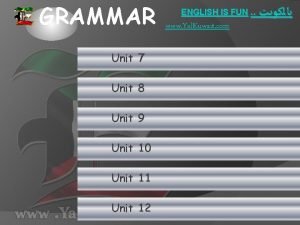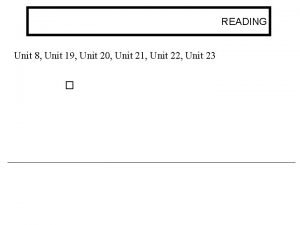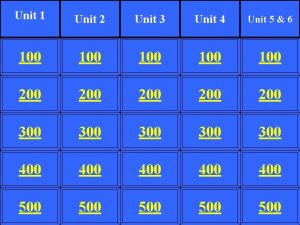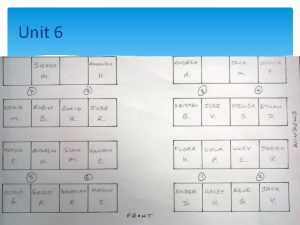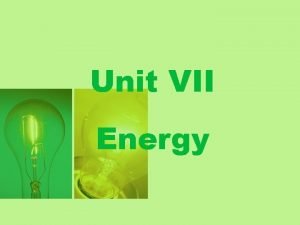Unit 7 Energy What is energy Energy the













- Slides: 13

Unit 7 - Energy

What is energy? Energy: the ability to do work or cause change Has different forms and can change between them (like currency or things of value: Dollars, Euros, gold, IPhones, buildings) Measured in Joules (J) 1 J = 1 N·m = 1 kg·(m/s 2)·m

Forms of energy (2 categories) 1. POTENTIAL ENERGY: (stored energy due to interactions between objects or stresses within a system). Includes… ◦ Gravitational potential energy: stored energy due to gravitational interaction between two objects

Forms of energy (2 categories) 1. POTENTIAL ENERGY includes… ◦ Elastic potential energy: stored energy of compressed or stretched object (springs and rubber bands)

Forms of energy (2 categories) 1. POTENTIAL ENERGY includes… ◦ Chemical potential energy: stored energy of chemical bonds (gasoline, firewood)

Forms of energy (2 categories) Speaking of chemical energy… Often measured in calories or Calories 1 calorie (cal) = 4. 18 J 1 Calorie = 1 kcal = 1000 calories Calories: what is found on nutrition labels

Forms of energy (2 categories) 2. OTHER FORMS (not exhaustive list) ◦ Kinetic energy: energy of motion ◦ Thermal energy: energy of heat (also often measured in calories) ◦ Electrical energy: energy of electric charges ◦ Radiant energy: energy of light ◦ Sonic energy: energy of sound

Energy can’t be lost, only “lost” Law of Conservation of Energy: Energy cannot be created or destroyed, but may change forms. Energy may be “lost” as heat, but it does not disappear

Mechanical Energy Mechanical energy: energy related to an object’s position and movement. Includes: 1. Kinetic Energy (KE) ◦ KE = 2 ½·m·v ◦ KE of a moving object is directly proportional to mass If mass increases 3 x, KE increases 3 x ◦ KE is exponentially proportional to velocity of object If velocity increases 4 x, KE increases 16 x

Mechanical Energy 2. Gravitational potential energy (GPE) ◦ GPE = m·g·h ◦ m = mass, g = acceleration due to gravity (9. 81 m/s 2), h = height relative to a reference point ◦ reference must be used/mentioned! ◦ The bigger the h or the bigger the m, the more GPE

Mechanical Energy 3. Elastic potential energy (EPE) ◦ EPE = ½ kx 2 ◦ k = spring constant, unique constant for each spring/material, x = distance stretched or compressed ◦ EPE is exponentially proportional to x ◦ If spring is stretched 3 x as much, EPE increases 9 x

Mechanical Energy If no energy is lost to friction or air resistance or as heat, mechanical energy is conserved (in reality this is never true) KEi + GPEi + EPEi = KEf + GPEf + EPEf We will usually only deal with two kinds (not all three) for any given problem (ignore one term on each side)

Mechanical Energy lost… In real life, energy is lost as heat. Examples: swinging on a swing without pumping eventually results in person sitting at rest because of air resistance and friction of bearings Roller coaster hills have to get smaller and smaller because of loss of energy to friction and air resistance
 Unit 6 review questions
Unit 6 review questions Hình ảnh bộ gõ cơ thể búng tay
Hình ảnh bộ gõ cơ thể búng tay Frameset trong html5
Frameset trong html5 Bổ thể
Bổ thể Tỉ lệ cơ thể trẻ em
Tỉ lệ cơ thể trẻ em Chó sói
Chó sói Glasgow thang điểm
Glasgow thang điểm Chúa yêu trần thế
Chúa yêu trần thế Kể tên các môn thể thao
Kể tên các môn thể thao Thế nào là hệ số cao nhất
Thế nào là hệ số cao nhất Các châu lục và đại dương trên thế giới
Các châu lục và đại dương trên thế giới Cong thức tính động năng
Cong thức tính động năng Trời xanh đây là của chúng ta thể thơ
Trời xanh đây là của chúng ta thể thơ Mật thư anh em như thể tay chân
Mật thư anh em như thể tay chân














